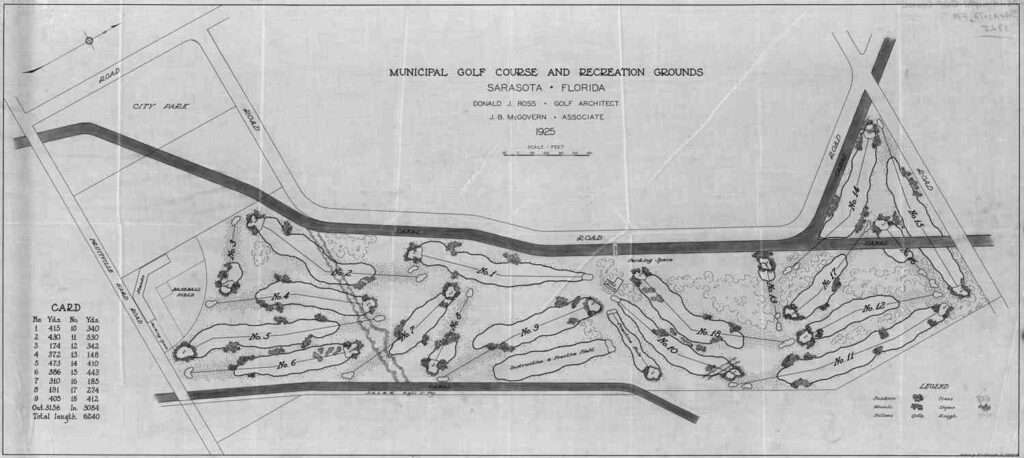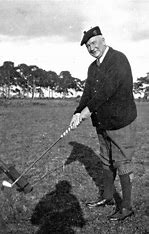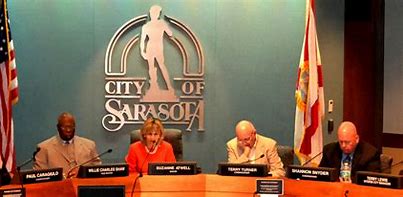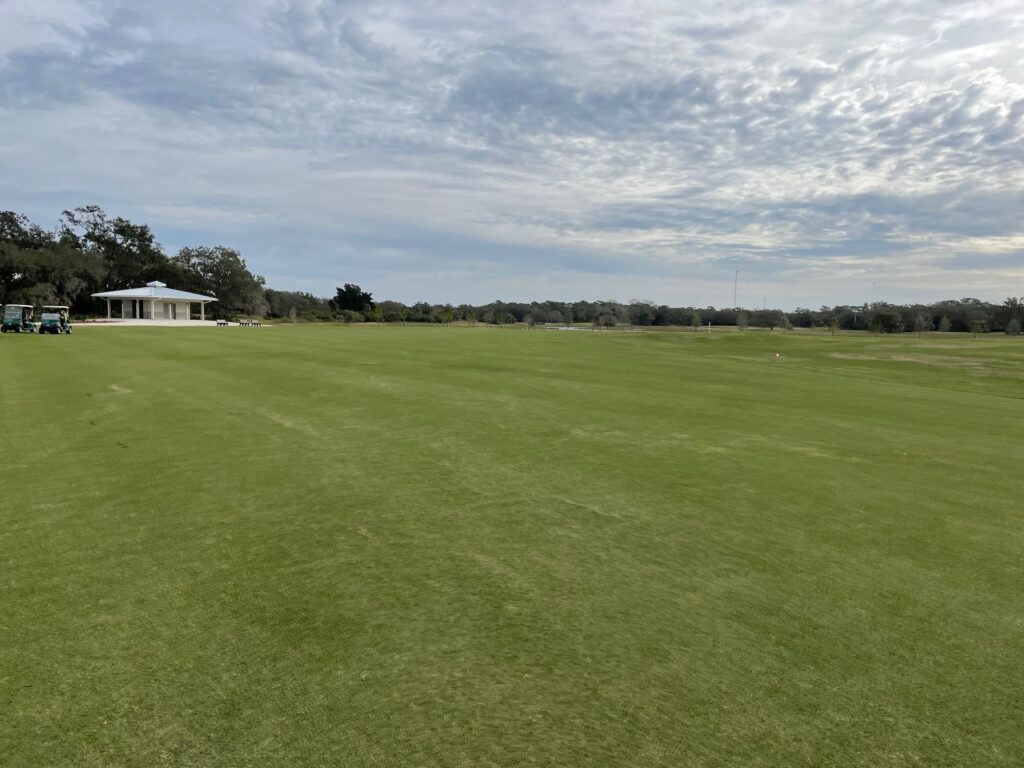After nearly 4 years, the Bobby Jones Golf Club has reopened. The restored golf course is stunning.
Here is a YouTube video of this post. Check it out and please subscribe. And here is a post with a Bobby Jones Course Review of all 18 holes with comments from golf course architect, Richard Mandell.
Like everybody else in Sarasota, I have been watching the progress while driving by on Fruitville Road or 17th Street. The grass looked great from a distance. And…

I am here to say Bobby Jones Golf Club is even better up close. The 18 holes follow the original layout Donald Ross designed in 1926.
The greens are larger and have more nuances and character than I remember. The fairways are wider with more mounding. You get the impression the elevation changes where, truth be told, none exist on the property. This is Florida.
Most impressive to me is the practice facilities. It is a Fun Factory, and I was blown away and will tell you more below.
In this post, I want to share some of the history of the golf course, the scope of the project, and discuss a few of the holes. Enjoy.
The golf course and project architect, Richard Mandell created a golf course that is fun for golfers of all skill levels. Mandell said it best himself, “Sarasota is going to see an eminently playable, fun golf course that’s true to the Ross plans.”
Sarasota Golf History

The history of the Bobby Jones Golf Club is rich. The City of Sarasota commissioned Donald Ross to design the Sarasota Municipal Golf Course and Recreation Grounds in 1925. The first nine holes opened for play on June 5th, 1926, and the back 9 a few months later on September 30th. The golf course measured 6240 yards and played as a Par 70.

The golf course was renamed Bobby Jones Municipal Golf Course in 1926. Bobby Jones was the first golfer to win the US Open and the British Open in the same year, 1926.

Jones was a Winter resident of Sarasota at the time, and sold real estate in the Whitfield Estates development where SaraBay Country Club sits, another Donald Ross golf course.
In 1927, Jones played in a dedication exhibition match at his namesake golf course.
Since opening, The Bobby Jones Municipal Golf Course hosted a PGA tournament in 1935, the Sarasota Open. Then the LPGA Tour played here in 1955 and 1956, again, the Sarasota Open.
Senior PGA Championship
Most prominent is the Senior PGA Championship, held twice at Bobby Jones Municipal Golf Course in 1940 and 1941.

The senior PGA Championship is the oldest of the five senior majors. Again, Bobby Jones himself was involved.
The first two Senior PGA Championships were held at Augusta National in 1938 and 1939, the first tournament other than The Masters held at Augusta National.
The weather in January is too wet in Augusta and so the event was moved south to Sarasota. This is the first major golf championship in Florida. The Alfred S. Bourne Trophy is awared to the winner, one of the largest cup-style trophies in all of golf, 36 pounds and 42 inches tall! A pretty cool bit of Sarasota golf history.
Previous Revisions
In 1952 nine holes were added to Bobby Jones adjacent to the original course, these holes were designed by Robert Bruce Harris, one of the founding members of the ASGCA and a colleague of Donald Ross, who died in 1948
Nine more holes were added near the back nine of the original course in 1967 by Sarasota golf architect, Roy Albert Anderson.
Also at this time, in 1967, the original golf course was divided, creating 2 18-hole courses, each with nine holes of the original Donald Ross design. This was probably a great idea at the time.
Lastly, the Gillespie executive nine-hole course was added in 1977 across the street.

Before I leave the history part of this post. I found it interesting that the first 9 holes of the Bobby Jones Municipal Golf Course opened just four days after the old course in Sarasota closed.
The Old Course was designed by John Hamilton Gillespie, the city’s first mayor, who arrived in Sarasota from Scotland in 1886 and soon after built two holes in what is now downtown Sarasota.
This wasn’t the first golf course in the United States, but it was certainly one of the earliest in the country. Gillespie turned his two holes Eventually into nine holes in and around what is now Main Street. Links Avenue and Golf Street are the last vestiges of Gillespie’s old course. pretty cool Golf history for Sarasota.
Before I move on I’ll leave a quick plug for my daily golf history podcast, Your Golfer’s Almanac. Give it a listen.
The Nature Park at Bobby Jones Golf Club
Before we take a look at the new golf course that opened on December 16th, 2023.
You should know that the course fell into disrepair over the years, for a variety of reasons, probably a lack of funds and a series of decisions due to limited funds. In short, the golf course wasn’t being maintained properly.
The mis-maintenance, I’ll call it, and flooding due to poor drainage in the below floodplain setting were persistent problems.
Bobby Jones was closed in 2020 and was left to go to seed while the City of Sarasota debated what to do with the property. People were allowed to walk and bike on the property but that was about it.

I was fortunate enough to participate in the Audubon Society‘s annual bird count for the last 4 or 5 years. I volunteered with a bird expert, Ed Hagen, and we spent a day estimating and identifying different birds at Bobby Jones.
All I really did was point out when I saw a bird and Ed would record the bird and estimate how many we saw, the count. Ed knows birds and it was pretty cool at the end of the day to see the long list of varieties or species of birds we saw. And I got a chance to see Bobby Jones when it was closed and overgrown. I could still see the routing and the outline of many of the holes.
City of Sarasota
The City of Sarasota commissioners deliberated on what to do and how much money to put into the facility. They considered a variety of options from many perspectives presented during numerous public meetings.

In January 2022, the City Commission approved more than $18 million for the golf course, a nature park, and wetlands conservation. The project reduced the 36 holes to 18 holes, though a short course is expected to open next year where the Gillespie executive course was previously located across Circus Boulevard. The perfect name for a street in Sarasota.
The larger objective for the project was water quality with the goal of enabling the golf course and the environment to work together, as Mandell has stated. The property is 307 acres and now includes a nature park. It is the largest green space in the city of Sarasota and collects stormwater from 5,800 urban acres surrounding the golf course.
Water Quality at Bobby Jones Golf Club

20 acres of wetlands were created with 14 1/2 acres of native grasses and nearly 50,000 nutrient-filtering aquatic plants were planted as part of the project. Along with the added wetlands, weirs were built to regulate stormwater and allow water to be naturally filtered before flowing into Sarasota Bay and ultimately the Gulf of Mexico.
The nature park is 90 acres and repurposes the golf cart paths into hiking and biking trails that circle the newly added wetlands.
My understanding is that previously when rain fell on the golf courses or anywhere nearby, the water flowed almost directly into Sarasota Bay.
Now the system created holds the water, allowing nitrogen and phosphorus to be removed naturally before the water flows into the intercoastal waters of Sarasota.
The estimate is for 900 pounds of nitrogen and 300 pounds of phosphorus to be removed from the water after flowing through the wetlands at Bobby Jones each year.
My hope is that the nitrogen and phosphorus removal will mitigate or reduce the red tide that we have been experiencing in Sarasota recently.
It’s a clever solution; solving the golf course’s drainage issues while incorporating a larger water quality plan for Sarasota.
The ultimate use of the property held up the city commissioner’s decision. Now the whole Bobby Jones property, over 300 acres, has been placed into a conservation easement, ensuring the property will remain a protected preserve of green space in perpetuity.
The New Bobby Jones Golf Club
OK, so that’s the history of Bobby Jones and the bigger picture for the project. Now, let’s get into the golf course.
I’ve lived in Sarasota for nearly 20 years and played both courses at Bobby Jones often. This is where we first contested our annual New Year’s Day 4-club challenge, something most people know nothing about. So, I have a lot of great memories of playing golf at Bobby Jones. It’s a big, big space with very little change in elevation.

As I have said, Bobby Jones Golf Club is absolutely stunning. Richard Mandell led the restoration and followed the original routing Donald Ross designed back in 1926. The original green complexes, bunkers, fairways, and tee boxes were rebuilt from the notes Ross took nearly 100 years ago. Mandel has given Sarasota a spectacular golf course, with the help of a huge team.
The superintendent for Bobby Jones Golf Club is Ian Murphy, another star of the project. Mandell planned the work and Murphy executed the vision and will be responsible for maintaining the golf course. This is a big project and Murphy has the experience for Bobby Jones Golf Club to thrive.
I’ll detail a few holes here and share some of the objectives Mandell balanced while completing the project.
Richard Mandell – Golf Course Architect
The entire golf course was raised using soil excavated from creating the wetlands. But the dimensions remain the same.
As Mandell shared, “When Ross called for a green to be 4 feet above the fairway, that green is still 4 feet above the fairway. The relative elevation changes don’t stray from the Ross notes, but everything’s been elevated.”
Entering the property, you immediately notice the wide open space. It feels massive. The property was overgrown with Brazilian pepper and other invasive trees and vines that Mandell removed. Big, beautiful trees, live oaks and palms, are no longer crowded out by invasives. The big trees were not present when the course opened in 1926, but they give the golf course a beautiful presentation and a grand scale.
Let’s have a look at a few holes starting with the first tee.
Hole #1
#1 is an introduction to what you can expect from the golf course. The old range and chain link fence to the left of the tee box have been removed. The view is wide and open. The fairway leads the eye slightly to the right, and you notice mounding as you move toward the green.

Again, in Mandell’s own words,
“We were really true to the Ross plan, which shows lots of mounding in the middle of the fairways. I don’t really recall many Ross courses that have that feature, and part of it is because he was smart in the sense that he knew it was low ground and so he utilized mounds as hazards instead of bunkers because if there was water on the course, it would be hard to drain bunkers. The mounding is really phenomenal and I think it’s going to catch people’s eyes.”
As you see on many of the holes, the mounds give the appearance of elevation change and Mandell employs them liberally throughout the Bobby Jones Golf Club. Remember, this is a flat piece of land.
The 1st green is big with many pinning options. The green is welcoming. The goal was fun, and the very definition, my definition of fun is a par on the first hole.
#1 measures 415 yards from the back tees. All of the tee complexes have six tees, so people can play distances that match their game. The first hole is a gentle way, a ‘Gentle Handshake’ in Ross-Speak, to begin your Bobby Jones Golf Club experience.
Hole #3

This is the first long par 3 on the golf course. The pond to the right is visible. Previously, the water was hidden behind very tall grasses, similar to the corn baseball players emerged from in the movie Field of Dreams.
Now you can see the pond and the splash if you decide to slice your approach shot there.
There is a bunker in the front right of the green that ends 15 or 20 yards from the edge of the green. A traditional Ross feature or trick, presenting an optical illusion from the tee box.
This is another big green that offers a wide entry from the left side. The two-tiered putting surface is higher in the back. There are many pin options and the possibility of 3 putts or more.
#3 measures 142 yards from the forward tees to 207 yards from the back.
Hole #7
The seventh is the most visibly appealing hole to my eye. The pond to the left of this short par 4 has been tidied up with proper banks, compared to the mud beach I remember.


A large rounded Banyan tree well behind the green frames the holes nicely. Perhaps a subtle reminder, that on many Ross holes, trouble is behind the hole, in the form of a steep fall-off. “Keep the green in front of you” is common advice when playing a Donald Ross-designed golf course.
#7 could be the most well-protected green on the golf course? If not, #7 has one of the least welcoming approach shots, but a hole must have some defense at 342 yards from the tips.
And, I sank a 25-foot curling par-saving putt on opening day, so this hole has a special place in my easy-to-please golf mind.
Hole #11 and #12
These two holes share a fairway, or the fairways run together. Both holes grant a wide berth for your tee shot.

#11 is a par 5 and you will want to lose it left rather than flirt with the OB on the right side. You will find the remenants of a pond on the left side before you get to the fairway. The space is still low-lying and will accumulate water after storms. The idea is a place for water to go rather than to collect on the golf course.
Mandell explained a berm prevented drainage along the right side of this fairway and previously caused flooding.
For #12, the hole offers a wide landing area from the tee. The approach shot seems to bottleneck a reasonably protected green with bunkers on either side and a set of bunkers some 30 yards from the green, another optical challenge.
The green rises making short pitches from behind the green hard to stop near a front pin.
Hole #16

The sixteenth is another long par 3 with a watery canal crossing in front of the green complex. There is a pond/canyon to the left. This hole is the highest green on the golf course, even after Mandell lowered the surface some 5 feet.
There is a bowl feel to #16 green, you walk over and down to the green from the cart path. This is a big green with ridges and nuances creating greens within the green.
Hitting the ball on the green can still leave you with a devilish 60-foot putt with two breaks. The par 3 16th measures from 129 to 190 yards.
Hole #18

Mandell commented on the tee boxes, “Most modern golf courses have tee boxes that are three, four, or five feet high. Ours are one to two feet high. It’s a little more challenging because your perspective drops. You’re not looking down as much on a fairway, so there’s an element of challenge there subconsciously.” Interesting note, and why the holes looked longer to me than they actually were.
The finishing hole has bunkers and problems to the right, and another grass collection area to the left of the fairway positioned to help after heavy rains.

The approach is fair but uninspired shots into #18 will find bunkers in front on either side of the green. The large 18th green slopes from back to front.
This is a proper finish to a proper 18 holes. And, if the goal is fun, you want to end with a good score, the way you started. Goal accomplished…though I made a double.
This finishing hole is waiting for a clubhouse to be built in a few years. Now there is a perfectly serviceable temporary clubhouse/pro shop that golfers and nature lovers can both enjoy.
Two other points I want to mention about the Bobby Jones Golf Club, the practice area and the Ross Tees.
The Ross Tees
The Ross Tees are one of the six tee sets and allow golfers the option of playing from the original distances designed by Donald Ross in 1926, 6240 yards. That means the tees on each hole change.
On one hole the Ross yardage might be from the back tee. On the next hole maybe the middle tee. The Ross Tees are circled on the scorecard. Golfers can easily find where to play the holes exactly as Donald Ross designed the golf course. Clever, as I’m sure Bobby Jones Golf Club will attract purists and many hickory devotees.
Practice Areas
For a ‘Range Rat’ like me, the practice area is perhaps the crown jewel of the whole project.

You will find a massive grass space and not a mat that I could see. The practice tee is wide with many targets to aim at, as well as large trees on the range, objects that you actually see on Bobby Jones Golf Club.
The driving range can accommodate over 70 spots. Even more impressive is the short-range area directly behind the practice tee. Multiple bunkers and three greens to pitch to. I see this practice area as a playground for anyone interested in fiddling and fine-tuning their game.
There is a small putting green by the 1st tee, and a larger putting green closer to the practice range that could be a putting course. Mandell referred to the putting area as “The Himalayas,” a nod to the St. Andrews Ladies’ Putting Club next to the Old Course at St. Andrews that has existed since 1867. Nice touch.
I’ll say it again, this is the nicest practice range I have ever seen, and I would be curious what else you could possibly want? Especially for a municipal golf course?? Bravo.
Big Scorecard
However, there is one thing they got wrong at Bobby Jones Golf Club. You knew it couldn’t be perfect, we are talking about the game of imperfections here. And, ask anyone, I can always find something to complain about. Here goes.

The scorecard is too wide or too big and it doesn’t fit into my faux leather scorecard holder. I started using it about a year ago, in a pathetic attempt to look like a tour professional. The card just doesn’t fit, I had to fold it over – Oh well. Nice problems to have. That is really the only bit of criticism I could find in the entire Bobby Jones Golf Club project.
The golf course is only going to mature and develop over time, and it only get better.
Bobby Jones Golf Club is an Ace. Well done Richard Mandell, Bravo City of Sarasota, and thank you, Ian Murphy.
GolfToons

Golftoons is a scheme between two golf buddies, Michael Duranko and Marty Glass. If this side hustle makes any money, they‘re gonna blow it on a golf trip. Check out our Etsy Shop for GolfToons Merchandise. Enjoy!
Your Golfer’s Almanac

Check out our daily golf history podcast, Your Golfer’s Almanac celebrating birthdays, milestones, and other accomplishments that have occurred on this day in golf history.
Since the golf course opened, you might find this post about the Bobby Jones Greens Fees and Mobile App interesting. And here is the short video.

